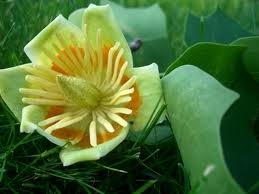The tulip poplar — Liriodendron tulipifera — is also known as the yellow poplar or tulip tree. It’s native to North America and grows throughout most of the United States, in USDA hardiness zones 4 through 9, tolerating winter temperatures as low as minus 25 degrees Fahrenheit. Known for its soaring height, and colorful flowers and foliage, the tulip poplar is very useful for landscaping, for wildlife and for construction.
Landscaping
-
The tulip poplar has many uses in the landscape, but is often limited due to its huge size. Tulip poplars grow rapidly up to 100 feet tall with a 20- to 40-foot spread in landscapes, but the trees can reach up to 200 feet tall in forests. The tulip poplar’s oval to rounded crown makes it a great shade tree in the landscape, while its tall, straight trunk sets the canopy high. The tree bears fragrant, showy flowers in late spring and early summer, bearing yellow leaves that turn green in summer and then yellow in autumn.
Plant tulip poplars in a location in your landscape that has full sunlight exposure and deep, fertile, moist but well-draining soil. Avoid areas where the tree will suffer excessive dryness during droughts. Also, you’ll likely need to provide some irrigation during summer to prevent leaf drop, so think about locating the tulip poplar in a spot that’s accessible to a water source or hose.
Wildlife
-
The colorful flowers on the tulip poplar tree attract bees and hummingbirds. The flowers produce an especially high-quality nectar that’s beloved by hummingbirds and bees alike. The tulip poplar is also a host plant for tiger and spicebush swallowtail butterflies. The tree attracts birds of various species and squirrels as well, with its seed-containing samara fruits. Unfortunately, the tulip poplar also attracts aphids, which like to feed on the foliage. Aphids excrete a sticky substance called honeydew, which can provide a growing medium for black sooty mold fungi.
Wood
-
Settlers and European lumber barons used tulip poplar wood to make houses and other structures, furniture and baskets. Aside from construction, tulip poplars were logged to make canoes, ships and paper pulp. But the wood was much weaker than that of other hardwood trees and pines, so the tulip poplar lumber wasn’t in high demand. Tulip poplars also have some medicinal uses. Mainly, the tulip poplar’s inner bark and roots contain hydrochlorate and tulipiferine. These are alkaloids used as heart stimulants.
Considerations
-
Before you plant tulip poplars in your landscape, consider the ultimate size of these large trees. Because tulip poplars can grow up to 100 feet tall in landscapes, they’re usually too big for most suburban and urban yards. In urban environments, the tulip poplar is sensitive to pollution, soil compaction and other environmental stressors. If you have a large yard, you may have room for the tulip poplar tree. City parks, farms and school grounds are also typically large enough to accommodate tulip poplars. Also, beware that tulip poplars are weak-wooded trees, causing easy breakage from high winds and ice storms.
History
-
The tulip poplar was one of the first trees shipped from North America back to Europe, mostly due to its huge size and abundance throughout the continent. Settlers used tulip poplars to find good farming land and groundwater, because the trees grew naturally in deep, well-draining, yet moist and fertile soils. The trees were also easy to spot due to their extreme height and striking appearance.


Deprecated: strpos(): Passing null to parameter #1 ($haystack) of type string is deprecated in /home/agriviek8Qv/agriviet.net/public_html/wp-includes/comment-template.php on line 2522